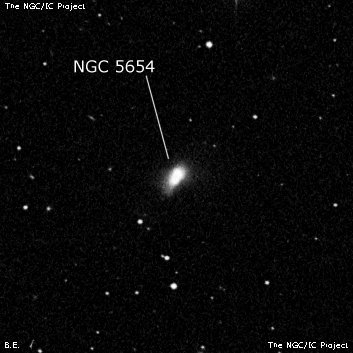
William Herschel discovered NGC 5654 = H III-420 = h1828 on 1 May 1785 (sweep 405) and noted "vF, S." On 11 Mar 1831 (sweep 331), John Herschel logged, "pF; nucleus elongated, or has a F double * in it. Pos = 115.5°± (micrometer)". His position matches UGC 9319 and the SDDS shows a double nucleus matching his description! The brighter nucleus is offset northwest of center as my description.
400/500mm - 17.5" (7/10/99): fairly faint, fairly small, elongated ~2:1 NNW-SSE, 1.4'x0.6'. Contains a small, round bright core. A mag 15 star lies 1.5' SE.
17.5" (6/20/98): fairly faint, fairly small, elongated 3:2 NW-SE. Sharply concentrated with a very small core that appears offset to the northwest side giving the impression of the galaxy possibly being double. A mag 15 star is 1.6' SE of center and a 50" pair of mag 13/14.5 stars lie 2'-3' S. The galaxy precedes a mag 9 star (SAO 64192) by 9'.
600/800mm - 24" (6/15/15): at 260x; moderately bright, fairly small, oval 3:2 NNW-SSE, small bright core. At 375x; NGC 5654 resolved into two merged components! The brighter nucleus is on the northwest side with the main glow of the galaxy offset mostly south-southeast. Often a fainter quasi-stellar nucleus (PGC 3577442 = SDSS J143001.68+362129.5) was seen very close south-southeast of the brighter nucleus. The two nuclei are just 12" apart! A mag 10 star lies 5.4' NNW and mag 9 HD 127505 is 9' E. A 6th magnitude star (HD 127065) lies 23' SW.
Notes by Steve Gottlieb